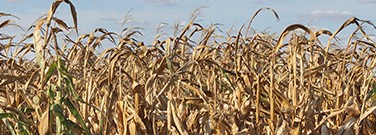Teens Win Awards for Drought-Fighting Technology

By Mark Miller
Two teen engineers have come up with award-winning technologies to help combat drought by determining how thirsty plants are and improving water management.
John Benedict Estrada, a sophomore at Clovis North High School in Fresno, California, developed a robotic arm that determines how thirsty plants are by measuring how they reflect light. He was awarded the $50,000 Gordon E. Moore Award for Positive Outcomes for Future Generations.
Arya Tschand, a senior at High Technology High School in Lincroft, New Jersey, used a flying drone as part of his drought-busting solution. It measures a plant’s thirst by the color of its leaves. He received the $10,000 Craig R. Barrett Award for Innovation from ISEF.
Detection by Reflection
Scientists can detect plant thirst or drought stress by measuring how dry the air is above a field or by taking the temperature of the plants themselves. John Estrada’s robotic arm uses an infrared camera to directly measure how red, green, and blue light reflects off bell pepper plants. How plants reflect light changes as they become drier. We can’t see these changes, but the infrared camera can. The robotic arm is also able to measure soil moisture and temperature.
The data collected by these instruments is fed into artificial intelligence computer software that uses machine learning to predict which plants will require water most.
Drone vs Drought
As Arya Tschand’s drone hovers over plants, it can measure how dry they are by the color of their leaves. Signals are then sent to an irrigation system on the ground that adjusts its output based on the color data. The system also includes a valve that connects to the irrigation pipes to optimize how much water is used.
Arya’s family is from India, and he got to see first-hand the effects of water shortages there. “I would gaze in utter disbelief across endless fields of wilted crops,” he told Bethany Brookshire at Science News for Students. One feature of his system is that it does not require internet access, which can be scarce in developing areas where better water management may be needed most.
Next Steps
The next steps for John Estrada’s robotic reflection device are already in the works. “I am planning to do a field experiment,” John told Science News for Students, “to collect field data and adapt my model to actual field conditions.”
As for Arya Tschand’s drone, he is also looking to scale. “I didn’t have a field of crops to test my drone on, so I used some plants I had at home.” According to Science News for Students, he is looking to broaden the scope of his system and has applied for a patent.
Discussion Questions
- Talk about the effects of water shortages around the world. How big is the problem and which areas are affected most?
- Discuss what computer models are and how they are used. What are some applications where creating simulations can help solve problems?
Vocabulary
- Infrared
- Artificial Intelligence
- Machine Learning